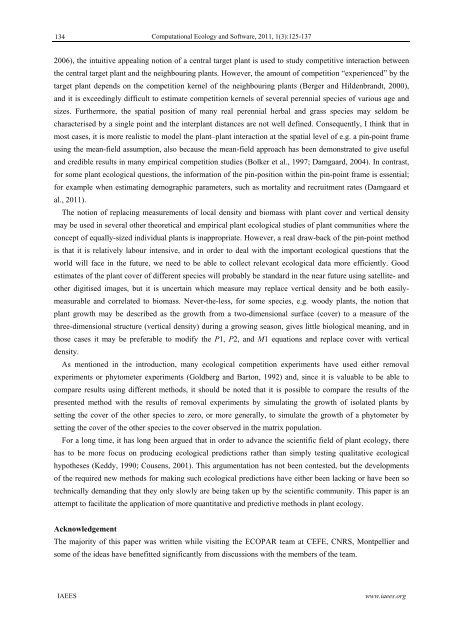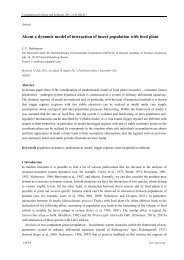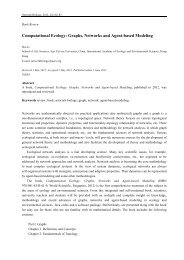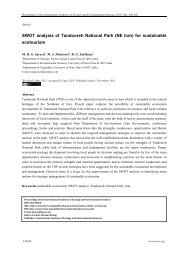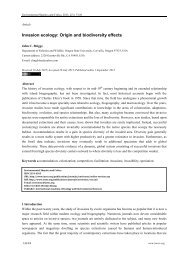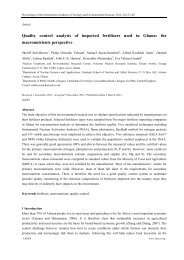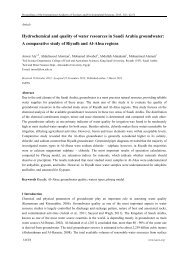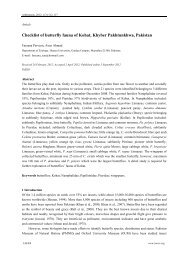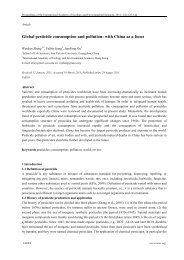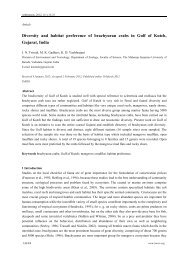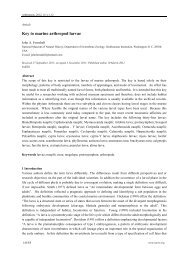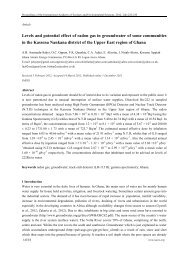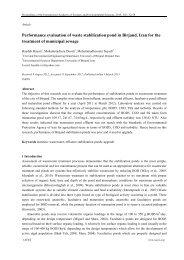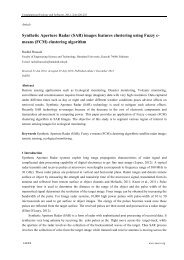Measuring competition in plant communities where it is difficult to ...
Measuring competition in plant communities where it is difficult to ...
Measuring competition in plant communities where it is difficult to ...
Create successful ePaper yourself
Turn your PDF publications into a flip-book with our unique Google optimized e-Paper software.
134<br />
Computational Ecology and Software, 2011, 1(3):125-137<br />
2006), the <strong>in</strong>tu<strong>it</strong>ive appeal<strong>in</strong>g notion of a central target <strong>plant</strong> <strong>is</strong> used <strong>to</strong> study compet<strong>it</strong>ive <strong>in</strong>teraction between<br />
the central target <strong>plant</strong> and the neighbour<strong>in</strong>g <strong>plant</strong>s. However, the amount of <strong>compet<strong>it</strong>ion</strong> “experienced” by the<br />
target <strong>plant</strong> depends on the <strong>compet<strong>it</strong>ion</strong> kernel of the neighbour<strong>in</strong>g <strong>plant</strong>s (Berger and Hildenbrandt, 2000),<br />
and <strong>it</strong> <strong>is</strong> exceed<strong>in</strong>gly <strong>difficult</strong> <strong>to</strong> estimate <strong>compet<strong>it</strong>ion</strong> kernels of several perennial species of various age and<br />
sizes. Furthermore, the spatial pos<strong>it</strong>ion of many real perennial herbal and grass species may seldom be<br />
character<strong>is</strong>ed by a s<strong>in</strong>gle po<strong>in</strong>t and the <strong>in</strong>ter<strong>plant</strong> d<strong>is</strong>tances are not well def<strong>in</strong>ed. Consequently, I th<strong>in</strong>k that <strong>in</strong><br />
most cases, <strong>it</strong> <strong>is</strong> more real<strong>is</strong>tic <strong>to</strong> model the <strong>plant</strong>–<strong>plant</strong> <strong>in</strong>teraction at the spatial level of e.g. a p<strong>in</strong>-po<strong>in</strong>t frame<br />
us<strong>in</strong>g the mean-field assumption, also because the mean-field approach has been demonstrated <strong>to</strong> give useful<br />
and credible results <strong>in</strong> many empirical <strong>compet<strong>it</strong>ion</strong> studies (Bolker et al., 1997; Damgaard, 2004). In contrast,<br />
for some <strong>plant</strong> ecological questions, the <strong>in</strong>formation of the p<strong>in</strong>-pos<strong>it</strong>ion w<strong>it</strong>h<strong>in</strong> the p<strong>in</strong>-po<strong>in</strong>t frame <strong>is</strong> essential;<br />
for example when estimat<strong>in</strong>g demographic parameters, such as mortal<strong>it</strong>y and recru<strong>it</strong>ment rates (Damgaard et<br />
al., 2011).<br />
The notion of replac<strong>in</strong>g measurements of local dens<strong>it</strong>y and biomass w<strong>it</strong>h <strong>plant</strong> cover and vertical dens<strong>it</strong>y<br />
may be used <strong>in</strong> several other theoretical and empirical <strong>plant</strong> ecological studies of <strong>plant</strong> <strong>commun<strong>it</strong>ies</strong> <strong>where</strong> the<br />
concept of equally-sized <strong>in</strong>dividual <strong>plant</strong>s <strong>is</strong> <strong>in</strong>appropriate. However, a real draw-back of the p<strong>in</strong>-po<strong>in</strong>t method<br />
<strong>is</strong> that <strong>it</strong> <strong>is</strong> relatively labour <strong>in</strong>tensive, and <strong>in</strong> order <strong>to</strong> deal w<strong>it</strong>h the important ecological questions that the<br />
world will face <strong>in</strong> the future, we need <strong>to</strong> be able <strong>to</strong> collect relevant ecological data more efficiently. Good<br />
estimates of the <strong>plant</strong> cover of different species will probably be standard <strong>in</strong> the near future us<strong>in</strong>g satell<strong>it</strong>e- and<br />
other dig<strong>it</strong><strong>is</strong>ed images, but <strong>it</strong> <strong>is</strong> uncerta<strong>in</strong> which measure may replace vertical dens<strong>it</strong>y and be both easilymeasurable<br />
and correlated <strong>to</strong> biomass. Never-the-less, for some species, e.g. woody <strong>plant</strong>s, the notion that<br />
<strong>plant</strong> growth may be described as the growth from a two-dimensional surface (cover) <strong>to</strong> a measure of the<br />
three-dimensional structure (vertical dens<strong>it</strong>y) dur<strong>in</strong>g a grow<strong>in</strong>g season, gives l<strong>it</strong>tle biological mean<strong>in</strong>g, and <strong>in</strong><br />
those cases <strong>it</strong> may be preferable <strong>to</strong> modify the P1, P2, and M1 equations and replace cover w<strong>it</strong>h vertical<br />
dens<strong>it</strong>y.<br />
As mentioned <strong>in</strong> the <strong>in</strong>troduction, many ecological <strong>compet<strong>it</strong>ion</strong> experiments have used e<strong>it</strong>her removal<br />
experiments or phy<strong>to</strong>meter experiments (Goldberg and Bar<strong>to</strong>n, 1992) and, s<strong>in</strong>ce <strong>it</strong> <strong>is</strong> valuable <strong>to</strong> be able <strong>to</strong><br />
compare results us<strong>in</strong>g different methods, <strong>it</strong> should be noted that <strong>it</strong> <strong>is</strong> possible <strong>to</strong> compare the results of the<br />
presented method w<strong>it</strong>h the results of removal experiments by simulat<strong>in</strong>g the growth of <strong>is</strong>olated <strong>plant</strong>s by<br />
sett<strong>in</strong>g the cover of the other species <strong>to</strong> zero, or more generally, <strong>to</strong> simulate the growth of a phy<strong>to</strong>meter by<br />
sett<strong>in</strong>g the cover of the other species <strong>to</strong> the cover observed <strong>in</strong> the matrix population.<br />
For a long time, <strong>it</strong> has long been argued that <strong>in</strong> order <strong>to</strong> advance the scientific field of <strong>plant</strong> ecology, there<br />
has <strong>to</strong> be more focus on produc<strong>in</strong>g ecological predictions rather than simply test<strong>in</strong>g qual<strong>it</strong>ative ecological<br />
hypotheses (Keddy, 1990; Cousens, 2001). Th<strong>is</strong> argumentation has not been contested, but the developments<br />
of the required new methods for mak<strong>in</strong>g such ecological predictions have e<strong>it</strong>her been lack<strong>in</strong>g or have been so<br />
technically demand<strong>in</strong>g that they only slowly are be<strong>in</strong>g taken up by the scientific commun<strong>it</strong>y. Th<strong>is</strong> paper <strong>is</strong> an<br />
attempt <strong>to</strong> facil<strong>it</strong>ate the application of more quant<strong>it</strong>ative and predictive methods <strong>in</strong> <strong>plant</strong> ecology.<br />
Acknowledgement<br />
The major<strong>it</strong>y of th<strong>is</strong> paper was wr<strong>it</strong>ten while v<strong>is</strong><strong>it</strong><strong>in</strong>g the ECOPAR team at CEFE, CNRS, Montpellier and<br />
some of the ideas have benef<strong>it</strong>ted significantly from d<strong>is</strong>cussions w<strong>it</strong>h the members of the team.<br />
IAEES<br />
www.iaees.org


